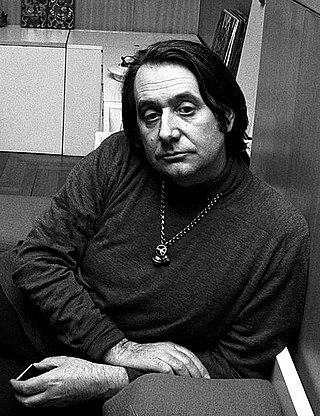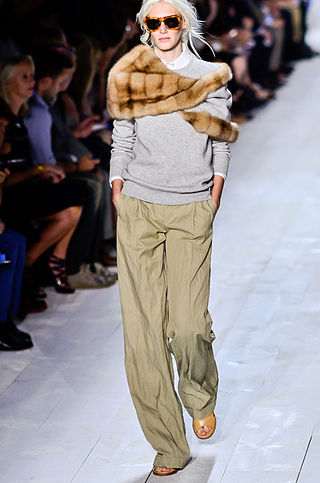
Ettore Sottsass was a 20th-century Italian architect, noted for also designing furniture, jewellery, glass, lighting, home and office wares, as well as numerous buildings and interiors — often defined by bold colours.

Mariacarla Boscono is an Italian fashion model and actress. Rising to fame in the early 2000s, Boscono has walked the runways of major worldwide fashion weeks and festivals, including Milan Fashion Week, New York Fashion Week and Paris Fashion Week, the Met Gala and Venice Film Festival. In 2005, over a two-week period, she walked more than seventy runways in three different cities, establishing a world record.

Tiiu Kuik is an Estonian fashion model.

Raquel Cristina Zimmermann is a Brazilian supermodel. She was announced as a Revlon ambassador in January 2018. Throughout her whole career Zimmermann has appeared on 37 Vogue covers. She currently ranks under "Icons" on models.com.

Designer clothing is clothing designed by a particular fashion designer or licensed by a person or brand. It is often luxury clothing proven to be high quality and haute couture for the general public, made by, or carrying the label of, a well-known designer. Licensing of designer names has been a common practice within the fashion industry since about the 1970s. Designer clothing comprises numerous types of apparel, including designer jeans that often cost several hundreds of dollars.

The term designer label refers to clothing, luxury automobile manufacturers and other personal accessory items sold under an often prestigious marque which is commonly named after a designer, founder, or a location-like where the company was founded. The term is most often applied to luxury goods. While members of the upper middle class, or the mass affluent, are perhaps the most commonly targeted customers of these designer labels, some marquees—such as Cartier, Rolex, Montblanc and the haute couture — tend to a wealthier customer base. But almost every designer brand has merchandise that the middle-class wouldn't normally be able to afford, such as exotic skins, furs and hides, limited edition pieces, or things simply priced higher. Designer label companies use their smaller and cheaper merchandise, aimed at the middle class, such as wallets, fashion jewellery, key-rings and small accessories, to make the majority of their income, whilst the more expensive pieces such as haute couture, high jewellery, hand-bags, shoes and even furnishings are usually reserved for the wealthier upper-class clientele.

Freja Beha Erichsen, also known as Freja Beha, is a Danish model. Dubbed as the "Queen of Cool", she is known for her androgynous look and for being one of the muses of the late Karl Lagerfeld.

Milan Fashion Week is a clothing trade show held semi-annually in Milan, Italy. Upcoming autumn/winter fashions are showcased in February/March of each year, and upcoming spring/summer fashions are showcased in September/October of each year. Many designers showcase new designs and upcoming collections. Milan Fashion Week is one of the "Big Five" global fashion weeks alongside New York, Paris, London, and Tokyo.

Romina Lanaro is an Argentine fashion model.
Danita Angell is an American model. She has appeared on the cover of Vogue Italia magazine and in the 2000 Victoria's Secret Fashion Show. Angell appeared in many runway shows for high-profile designers in the late 1990s and early 2000s. Her couture runway appearances include Balmain, Chanel, Christian Lacroix, Givenchy, Valentino and Versace. She also walked in ready-to-wear shows for notable designers such as Alexander McQueen, Balenciaga, Calvin Klein, Chanel, Christian Dior, Dolce & Gabbana, Dries van Noten, Fendi, Givenchy, Gucci, Helmut Lang Jil Sander, John Galliano, Louis Vuitton, Marc Jacobs, Missoni, Miu Miu, Moschino, Oscar de la Renta, Prada, Ralph Lauren, Roberto Cavalli, Valentino, Versace, Vivienne Westwood and Yves St. Laurent. She has also appeared in advertising for designers including Missoni, Roberto Cavalli and Versace. She was named as a new millennium it girl by Harper's Bazaar along with Kate Moss and Amber Valletta, and was photographed with Caroline Ribeiro by Steven Meisel for Vogue Italia's editorial 'Danger High Voltage' in December 1999. In 2001, she was photographed for the New York Times Magazine twice, in February in the Doris Duke home, and in October in the Mark Twain House.
Italy is one of the leading countries in fashion design, alongside France and the United Kingdom. Fashion has always been an important part of the country's cultural life and society, and Italians are well known for their attention to dress; la bella figura, or good appearance, retains its traditional importance.
Eugenia "Zhenya" Volodina is a Russian model. Volodina started her career in 1998 and later in the 2000 she was signed by a Parisian modelling agency. Volodina managed to carry the Victoria's secret wings, has modelled for Victoria's Secret in 2002, 2003, 2005, 2007 and was the only non angel to open a segment in 2005.

Domenico Mario Assunto Dolce is an Italian fashion designer and entrepreneur. Along with Stefano Gabbana, he is one half of the luxury fashion house Dolce & Gabbana (D&G). Since founding D&G in 1985, Dolce has become one of the world's most influential fashion designers and an industry icon.

Andreea Diaconu is a Romanian model. She is one of the most popular models from Romania. She has been featured on the covers of magazines from France, Romania, Russia, Spain, and Switzerland. Diaconu posed for Vogue magazine for the first time at age 21, for the February 2013 issue. She is the face of Gucci, Dolce & Gabbana, and Belstaff. In 2014, she was part of the spring campaign for Belstaff, featuring David Beckham.
Made in Italy is a merchandise mark indicating that a product is all planned, manufactured and packed in Italy, especially concerning the design, fashion, food, manufacturing, craftsmanship, and engineering industries.

Ruby Rose Aldridge is an American fashion model and singer. During the years of 2008 - 2012, Ruby Aldridge was the "face" of brands such as Coach, Marc by Marc Jacobs, Valentino, and Calvin Klein. During the 2011 fall fashion week, Aldridge opened four fashion shows which placed her, at that time, 7th in terms of the number of these appearances in a given fashion week. As of this date, she has walked in nearly 200 fashion shows, including for top designers such as Alberta Ferretti, Missoni, Sonia Rykiel, Valentino, Dolce & Gabbana, Marc Jacobs, and others, and has appeared on the covers of Harper's Bazaar, L'Express Styles, and L'Officiel, and in major magazine spreads in The New York Times, Vanity Fair, and in the Vogue editions of several countries. Ruby Aldridge is the daughter of former Playboy playmate Laura Lyons and artist and graphic designer Alan Aldridge, and younger sister of fashion model Lily Aldridge.
Marpessa Hennink is a Dutch fashion model. She is best known for her work as a runway model, which earned her the moniker “The Catwalk Contessa”.

Alexis Makenzie Boling, is an American fashion model. She is best known for her multiple covers for Vogue Italia and her appearances in numerous Prada campaigns.

Maartje Verhoef is a Dutch fashion model.

![Sacco | Piero Gatti, Cesare Paolini, Franco Teodoro [1968]. Sacco is part of the permanent collection of 27 museums of modern art worldwide. Sacco was awarded the Compasso d'Oro in 2020. ' Sacco.jpg](http://upload.wikimedia.org/wikipedia/commons/thumb/5/52/%27_Sacco.jpg/220px-%27_Sacco.jpg)


















